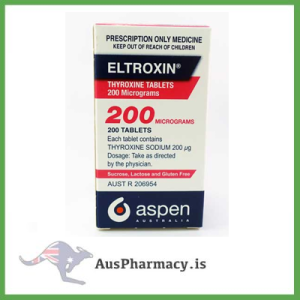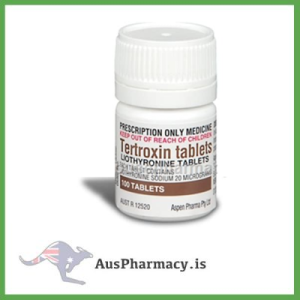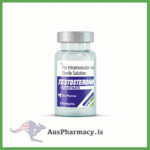T4 Thyroxine 200 x 200mcg Tablets
T4 Thyroxine (200 x 200 mcg) represents a foundational compound for studying the thyroid hormone system, a key regulator of human metabolism and energy balance.
In educational and pharmaceutical science contexts, it serves as a reference molecule for understanding hormone biosynthesis, regulation, and pharmacological replacement mechanisms.
This article provides a comprehensive educational insight into T4’s chemistry, physiological role, and academic research relevance.
2. Chemical and Pharmacological Profile
-
Chemical Name: L-thyroxine (Tetraiodothyronine)
-
Molecular Formula: C15H11I4NO4
-
Molecular Weight: 776.87 g/mol
-
Drug Class: Thyroid hormone analogue
-
Type: Synthetic form of naturally occurring thyroxine (T4)
T4 Thyroxine functions as a prohormone, converted into triiodothyronine (T3), the biologically active form responsible for cellular metabolic regulation.
3. Biological Role and Mechanism of Action
The thyroid hormones T3 and T4 are essential regulators of:
-
Basal metabolic rate
-
Protein synthesis and lipid metabolism
-
Thermoregulation and oxygen consumption
-
Growth and development
Mechanistically, T4 acts as a precursor that undergoes deiodination to form T3. T3 then binds to nuclear thyroid hormone receptors, influencing gene expression and mitochondrial activity.
Educational models emphasize this mechanism to explain nuclear receptor signaling and transcriptional regulation.
4. Educational Importance
T4 Thyroxine 200 mcg is invaluable for teaching:
-
Endocrine system regulation
-
Feedback loops involving the hypothalamus and pituitary
-
Pharmacokinetic modeling of hormone analogues
-
Molecular signaling in hormone–receptor interactions
Students studying pharmacology and physiology use T4 to understand homeostasis and metabolic adaptation.
5. Endocrine Feedback Regulation
T4 is part of the hypothalamic–pituitary–thyroid (HPT) axis, a key educational concept in endocrinology:
-
Hypothalamus secretes thyrotropin-releasing hormone (TRH).
-
Pituitary gland releases thyroid-stimulating hormone (TSH).
-
Thyroid gland produces and secretes T4 and T3.
-
High circulating T4 levels provide negative feedback to the pituitary and hypothalamus.
This feedback loop is commonly demonstrated in hormonal regulation coursework.
6. Pharmacokinetics and Metabolism
For educational reference, T4’s pharmacokinetic profile includes:
-
Absorption: Incomplete but significant oral absorption (~70–80%)
-
Distribution: High protein binding (thyroxine-binding globulin, transthyretin, albumin)
-
Metabolism: Deiodination in liver, kidney, and other tissues
-
Half-life: Approximately 7 days (reflecting stable metabolic function)
-
Excretion: Primarily via urine and feces
These parameters serve as teaching examples for drug metabolism, protein binding, and systemic bioavailability.
7. Structural and Molecular Characteristics
T4’s structure includes four iodine atoms on a tyrosine-derived backbone, making it highly distinctive in biochemistry.
Educational focus points:
-
Iodination steps in thyroid hormone synthesis
-
Thyroglobulin as a precursor molecule
-
Enzymatic catalysis by thyroid peroxidase
These elements illustrate biosynthetic enzyme activity and trace element dependency (iodine’s biological role).
8. Laboratory and Academic Research Applications
T4 Thyroxine is used in academic laboratories for:
-
Endocrine feedback modeling
-
Metabolic rate and oxygen consumption studies
-
Gene transcription analysis
-
Pharmacokinetic simulations
In physiology labs, experiments often involve model organisms or cell cultures to measure T4’s metabolic effects.
9. Comparative Educational Studies
Comparisons between T4 and T3 provide valuable educational insights:
| Feature | T4 (Thyroxine) | T3 (Triiodothyronine) |
|---|---|---|
| Iodine Atoms | 4 | 3 |
| Potency | Lower | Higher |
| Duration | Longer | Shorter |
| Role | Prohormone | Active hormone |
Such comparisons demonstrate how small structural changes yield significant pharmacological differences.
10. Role in Cellular and Genetic Regulation
Thyroxine’s educational value extends to cellular and molecular biology, as it:
-
Regulates mitochondrial biogenesis
-
Enhances protein synthesis and RNA polymerase activity
-
Influences cellular oxygen utilization
-
Modulates neural and skeletal development
These aspects make it an ideal example for studying hormone-driven gene expression.
11. Pharmaceutical and Chemical Education
From a pharmaceutical perspective, students can learn about:
-
Formulation stability of hormone analogues
-
Storage conditions and degradation pathways
-
Pharmacological equivalence and bioavailability
-
Quality assurance in tablet production
This knowledge bridges theoretical biochemistry with industrial pharmaceutical processes.
12. Research in Endocrine and Metabolic Disorders
In educational research, Thyroxine is studied to understand disorders such as:
-
Hypothyroidism (underactive thyroid)
-
Hyperthyroidism (overactive thyroid)
-
Iodine deficiency and metabolic dysregulation
These studies allow medical and pharmacy students to examine clinical physiology and therapeutic mechanism design.
13. Ethical and Educational Handling
T4 Thyroxine 200 mcg should only be used under academic supervision for educational or research demonstrations.
Students are taught about laboratory ethics, controlled handling, and scientific responsibility when using any hormone analogues.
14. Modern Educational Relevance
T4 remains a core topic in:
-
Biomedical and pharmacology courses
-
Endocrinology training
-
Metabolic and biochemical education
-
Molecular medicine programs
Its use in simulation and biochemical modeling continues to advance understanding of hormonal balance and cellular metabolism.
15. Conclusion
T4 Thyroxine 200 x 200 mcg is not only a synthetic representation of a critical human hormone but also a cornerstone of educational pharmacology and endocrine system learning.
Through the study of its chemical structure, metabolic regulation, and physiological feedback, students gain insight into how hormones maintain homeostasis.
It serves as an essential academic example of biochemical control mechanisms, receptor signaling, and pharmaceutical formulation science.








